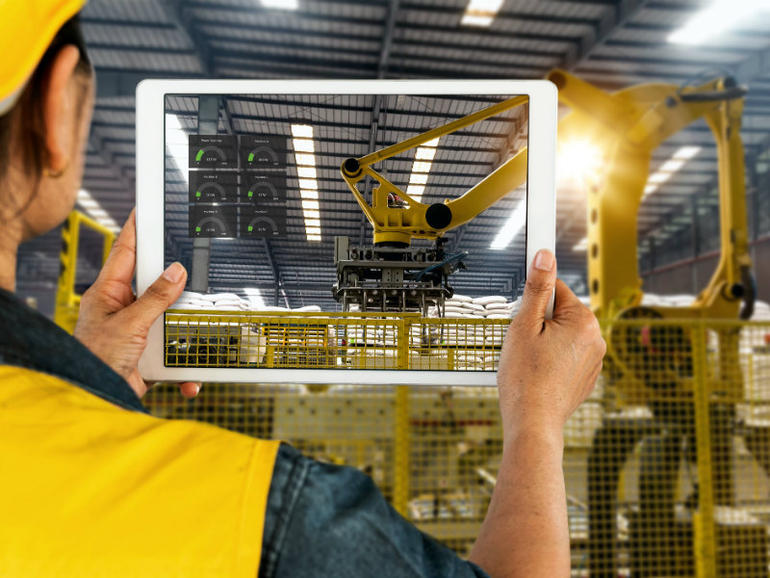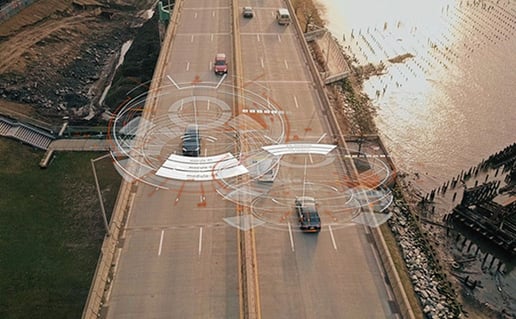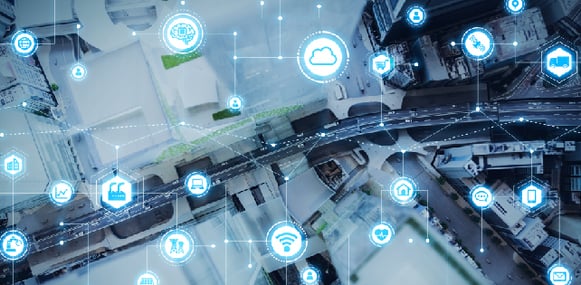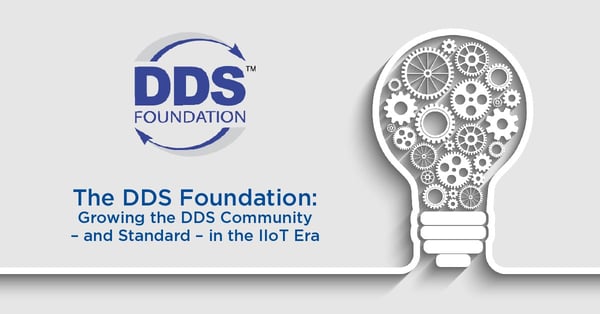
Five years after the Industrial Internet of Things (IIoT) burst into corporate consciousness, much has been discussed and written about this powerful new era of connected, intelligent machines and devices. Since most of that information is scattered across the digital landscape, RTI has consolidated the ‘what,’ ‘why,’ ‘how,’ and ‘where’ of the IIoT. Your feedback on this material is welcome; please contact us at info@rti.com.
Introduction to the Industrial Internet of Things (IIoT)
The Internet has transformed how people communicate, what they do and how they work together. Now, attention has shifted to doing the same for machines. For the past few years, systems developers have focused on interconnecting sensors, edge nodes and analytics to build smart systems, transforming operations into significant productivity environments. These connected systems make up what is called the Industrial IoT (IIoT).
This fourth industrial revolution is the most disruptive in industrial automation history, affecting industries from healthcare to energy, transportation to manufacturing. Not only is the pace of change accelerating, but so too are the technological leaps. In the next few years, engineers in every industry will find a way to leverage the new capabilities generated by connecting machines and processes with more powerful compute and analytics capabilities.
What is the Industrial Internet of Things (IIoT)?
Let’s start with a common definition. IIoT refers to the interrelated, automated use of machines, devices and sensors that run industrial applications. With a strong focus on big data and machine learning, the IIoT enables industries and enterprises to increase efficiency and reliability in their operations, with reduced reliance on human-to-machine interactions. It also enables new business models or revenue sources from useful data that is collected and shared.

The influential Industrial Internet Consortium defines IIoT systems as: The internet of things, machines, computers and people, enabling intelligent industrial operations using advanced data analytics for transformational business outcomes.
For a more in-depth introduction to IIoT, please download and read the Rise of the Robot Overlords, an e-book by RTI CEO Stan Schneider. For a shorter introduction, this IDG video provides a quick overview.
IoT and IIoT: What’s the Difference?
The term “Internet of Things” first surfaced in a presentation by Kevin Ashton, co-founder of MIT’s Auto-ID Lab, to Proctor & Gamble in 1999. Initial work in IoT was focused on home-based consumer applications. Remember the hype generated by the earliest connected refrigerator, letting you know that it was out of eggs?
IoT is a superset of all connected applications (consumer and industrial). It is typically used to describe connected applications in consumer markets such as wearables, temperature control, home security systems, shopping, travel planning applications and more. IoT has disrupted industries from entertainment to travel, shopping to personal healthcare, and has an estimated market size is in the hundreds of billions of dollars, according to various market analysts. The rapid growth is a result of the push-pull of market forces, as the consumer demand for the convenience and services of smart, connected applications is matched by corporate interest in collecting and leveraging that same data into new growth opportunities.
IIoT - industrial IoT - is a subset of IoT and focuses specifically on industrial applications such as transportation, manufacturing, energy and agriculture. Notably, IIoT has different technical requirements given its increased level of complexity, interoperability and security needs. The same technology that monitors your personal fitness device is entirely different from the systems needed to run advanced industrial applications such as autonomous air taxis or remote robotic surgery. Both IoT and IIoT have technical challenges, but the risks and complexities for autonomous industrial applications are inherently higher.
IIoT enablement has made great strides from cross-industry, public-private collaboration. Over the past few years, thousands of universities, companies, consortia and standards organizations have come together to work on the technical innovation necessary to make IIoT work in a secure, scalable and reliable way.
Industrie 4.0 and IIoT
Industrie 4.0 (also known as Industry 4.0) was initiated by the German government as part of its “High-Tech Strategy 2020” in 2010. Industrie 4.0 is all about connected value chains: Industrial industries can connect and automatically integrate things and processes to form cyber physical systems. The ultimate goal of Industrie 4.0 is to increase the value in manufacturing environments and reduce waste through the use of new technologies.
In the early days of IIoT, there was a fair amount of effort made by both Industrie 4.0 and IIoT proponents to differentiate the two initiatives. After a rather exhaustive analysis, this has now given way to the consensus that there are more similarities than differences in their approaches. Today, Industrie 4.0 is often used interchangeably with Industrial Internet of Things (IIoT). Both terms refer to connecting machines with other machines/devices and analytics in order to improve productivity and results.
Top IIoT Industries and Applications

IIoT applications are found in nearly every industry including:
- Aerospace (airports, airplanes, drones and other unmanned air vehicles)
- Agriculture (connected farms)
- Automotive (connected, semi-autonomous and autonomous vehicles)
- Energy Systems (smart grid, distributed energy resources (DERs) and renewable energy)
- Healthcare (connected healthcare, robotic surgery and medical imaging)
- Manufacturing (connected factories)
- Military (military vehicles, simulations, training and operations)
- Oil & Gas (exploration and refining)
- Smart Cities (citizen and municipal services, parking and infrastructure, etc.)
- Transportation (buses, subways, trains and Hyperloop)
IIoT also runs cross industry applications including:
How IIoT Works?
Typical IIoT systems require data to be shared between multiple devices and across multiple networks, from the edge (sensors, remote devices and computers) to the cloud (centralized computer systems). This is challenging because the sheer volume of data – not to mention the stringent safety and security requirements – can easily overwhelm a network, particularly one that spans across remote operations. These interconnected systems require new ways to manage increased data volume, performance requirements, security risk and safety certifications.
Managing IIoT dataflow is critical to ensuring IIoT applications work as designed. A proven architecture put forward by the Industrial Internet Consortium is the databus. In contrast with a database, which manages historical data at rest, the databus manages data in motion.
A databus is a data-centric software framework that distributes and manages real-time data in the IIoT, enabling applications and devices to work together as one integrated system. The databus simplifies application and integration logic. Instead of exchanging messages, software components communicate via shared and filtered data objects. Applications directly read and write the value of these data objects, which are cached locally.
For more information on how the databus works, please visit RTI’s webpage on the topic.
IIoT Connectivity

As previously described, IIoT applications are data dense and require high reliability. The connectivity layer, or framework, is critical to accommodate the rapid exchange of high volume data. The Industrial Internet Consortium published the Industrial Internet Connectivity Framework (IICF) to map and clarify the confusing landscape of connectivity solutions. It provides recommendations to help unlock data in isolated systems, enable data sharing and interoperability between previously closed components and subsystems (brownfield) and to accelerate the development of new applications (greenfield) within and across industries.
The IICF defines a reference architecture for opening up data otherwise locked in a number of domain-specific connectivity technologies used in IIoT systems. It uses gateways to one of a few core connectivity standards that can provide syntactic interoperability without compromising the fidelity of the functional and non-functional aspects of the domain-specific technology. This framework recommends the databus architecture, as described above, for the peer-to-peer communication necessary for agility and volume of IIoT applications.
IIoT for Engineers, Developers and Architects
In addition to streamlining operations, IIoT will rewrite vendor relationships, redefine profitability, and re-invent delivery from environment to cost to product. Thus, IIoT systems cannot be created in isolation. Given the investment, they must be designed to run for several years, even decades. For IIoT system engineers, architects and developers working to develop these next generation systems, they must start with the fundamental truth that their system must work flawlessly with the unknown. If you are a designer, your challenge is to look beyond today's experience into a future that will be dominated by intelligent computing. Above all, you need to think about a system that can scale and integrate with the unknown systems of the future.
New systems must be based on proven IIoT standards in order to be ‘future proofed’ and also to ensure they have the necessary interoperability, scalability and security necessary for data-driven systems. The Industrial Internet Reference Architecture provides a standards-based architectural template and methodology for system architects to design their systems based on a common framework and concepts. First published by the Industrial Internet Consortium in 2015, the latest version was released in June 2019 and is available for download.
DDS in IIoT Systems
 There are many communications middleware standards and products. The Data Distribution Service TM (DDS) standard by the Object Management Group® (OMG) was developed for complex, distributed systems. DDS is uniquely data centric, which is ideal for implementing a layered databus architecture in IIoT systems. It has been successfully deployed in thousands of systems, ranging from undersea robotics to NASA initiatives including space launches. DDS is a middleware protocol and API standard that provides data connectivity, extreme reliability and a scalable architecture to meet IIoT application requirements. The data centricity of DDS ensures that all messages include the contextual information that an application needs to understand the data it receives. Rather than writing specific code, developers can use DDS to specify how and when to share data/data values. View the short video on how DDS works with industrial systems.
There are many communications middleware standards and products. The Data Distribution Service TM (DDS) standard by the Object Management Group® (OMG) was developed for complex, distributed systems. DDS is uniquely data centric, which is ideal for implementing a layered databus architecture in IIoT systems. It has been successfully deployed in thousands of systems, ranging from undersea robotics to NASA initiatives including space launches. DDS is a middleware protocol and API standard that provides data connectivity, extreme reliability and a scalable architecture to meet IIoT application requirements. The data centricity of DDS ensures that all messages include the contextual information that an application needs to understand the data it receives. Rather than writing specific code, developers can use DDS to specify how and when to share data/data values. View the short video on how DDS works with industrial systems.
DDS has an open interface and has been adopted by standards in industries including automotive (AUTOSAR Adaptive), avionics (FACE), grid modernization (OpenFMB), medical (OpenICE, MD PnP) and more. DDS is also a designated Core Connectivity Standard by the Industrial Internet Consortium.
The ROI of IIoT
IIoT streamlines and automates, leading to productivity gains, more efficient operations, cost savings and revenue-generation opportunities. Higher levels of automation and improved product quality, combined with more efficient operations through predictive maintenance, are just some of the ways that IIoT can streamline operations. Staff can be shifted to perform higher-value tasks.
IIoT also generates new revenue streams through the data generated. Information gleaned from smart machines and devices add insights, value and profits from more efficiently run operations. Data from performance or usage can be used to form new products or services, new business models and additional revenue streams. For example, manufacturers can create new asset-sharing models with other manufacturers, to share resources at times of under-utilization or peak capacity. The data can yield insights into patterns that reveal opportunities for cost savings or growth.
For example, in a smart building where IIoT devices monitor energy consumption, the building owner can use the data to optimize efficiencies, such as ensuring the windows aren’t open while the air conditioning is running or that the lights are turned off when no one is in the meeting room. This is now routine practice, yielding energy and cost savings. Yet the building owner can generate even more revenue by selling that IIoT generated data to a utility provider. That utility in turn, will aggregate this data with data from thousands of buildings to help predict and regulate energy consumption.
In short, IIoT can improve productivity and quality, while freeing up resources to help businesses to expand in new directions.
Barriers to IIoT
While the benefits of IIoT are numerous, barriers to adoption remain. Two of the biggest hurdles are security and interoperability. To understand what’s on the minds of industry executives, listen in on conversations in this short video.
When physical systems go online, there are substantial benefits, but there are also increased risks from external and, yes, internal threats. Cyberattacks can inflict damage to the systems causing huge financial losses at best and serious injuries or even death at worst. IIoT security is something that must be designed into the IIoT system from the ground up, not as an additional protective layer after the system has been built. There are several excellent resources on security, yet it still remains the top concern of IIoT systems.
Interoperability is another challenge. Connected IIoT systems rely on rapid, immediate and 100% accurate data exchange, across systems and across geographic areas. From the sensor to the machine to the enterprise system, data needs to be collected, analyzed, stored, retrieved and acted upon, seamlessly. Lack of interoperability and lack of standards between IIoT sensors, devices, and applications hinder the communications of IIoT systems. Progress has been made through collaborative efforts in the previously-described Industrial Internet Connectivity Framework, as well as through the work of standards organizations through the DDS standard among others. Industries can leverage these standards to mitigate risk in developing and deploying IIoT systems.
RTI and IIoT
Data-centric connectivity is critical to making high performance, intelligent IIoT systems work as designed. As the commercial leader in DDS, RTI has the connectivity framework that runs IIoT environments at the bottom of the ocean to outer space, from autonomous transportation to connected healthcare. We invite you to talk to us about how you can benefit from using real-time, highly-reliable connectivity in your IIoT systems.
Related Content:
- [eBook]The Rise of the Robot Overlords: Clarifying the IIoT
- [Webinar] The Rise of the Robot Overlords: Clarifying the IIoT
- [Podcast] Clarifying the IoT
- [Webinar] Industrial IoT Security - the OT Infrastructure Shift
- [Webinar] IoT and Edge Computing - panel discussion
- [Whitepaper] A Converged Approach to Standards for Industrial Automation
- [Webinar] Five ways to Improve Reliability in IIoT Systems
- [Whitepaper] The Secret Sauce of Autonomous Cars
- [Webinar] Embracing the IoT in Healthcare: Ideas are Easy, Execution is Hard
Posts by Tag
- Developers/Engineer (177)
- Connext DDS Suite (77)
- Technology (74)
- News & Events (73)
- 2020 (54)
- Standards & Consortia (51)
- Aerospace & Defense (48)
- Automotive (35)
- 2023 (34)
- 2022 (29)
- IIoT (27)
- Leadership (24)
- 2024 (22)
- Cybersecurity (20)
- Healthcare (20)
- 2021 (19)
- Connectivity Technology (15)
- Military Avionics (15)
- Culture & Careers (14)
- FACE (13)
- Connext DDS Pro (10)
- JADC2 (10)
- ROS 2 (10)
- 2025 (7)
- Connext DDS Tools (7)
- Connext DDS Micro (6)
- Databus (6)
- Transportation (5)
- Case + Code (4)
- Connext DDS (4)
- Connext DDS Cert (4)
- Energy Systems (4)
- FACE Technical Standard (4)
- Oil & Gas (3)
- RTI Labs (3)
- Research (3)
- Robotics (3)
- #A&D (2)
- Connext Conference (2)
- Edge Computing (2)
- MDO (2)
- MS&T (2)
- TSN (2)
- ABMS (1)
- C4ISR (1)
- ISO 26262 (1)
- L3Harris (1)
- LabView (1)
- MathWorks (1)
- National Instruments (1)
- Simulation (1)
- Tech Talks (1)
- UAM (1)
- Videos (1)
- eVTOL (1)
 Success-Plan Services
Success-Plan Services Lynne Canavan
Lynne Canavan